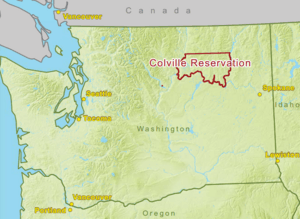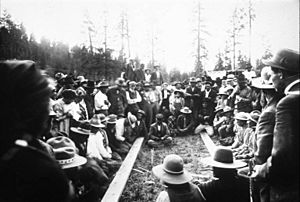Colville Indian Reservation facts for kids
Quick facts for kids
Colville Indian Reservation
|
|
|---|---|

Outline of the Colville Reservation
|
|
| Tribe | Confederated Tribes of the Colville Reservation |
| Country | United States |
| State | Washington |
| County | Okanogan County, Washington and Ferry County, Washington |
| Headquarters | Nespelem |
| Area | |
| • Total | 11,430 km2 (4,410 sq mi) |
| Website | Colville Tribes |
The Colville Indian Reservation is a special area of land in north central Washington. It is home to and managed by the Confederated Tribes of the Colville Reservation. These tribes are officially recognized by the United States government.
The reservation was created in 1872. Today, it covers about 2.8 million acres (11,430 square kilometers). Most of this land is in Okanogan County and Ferry County. The reservation's name comes from Fort Colville, which was named after Andrew Colville from the Hudson's Bay Company.
The Confederated Tribes include about 8,700 people who are descendants of twelve different Native American tribes. These tribes are the Colville, Nespelem, Sanpoil, Lakes (Sinixt), Palus, Wenatchi, Chelan, Entiat, Methow, southern Okanagan, Sinkiuse-Columbia, and Nez Perce (Chief Joseph's Band). Some members of the Spokane tribe also moved to the reservation later.
The most common native language spoken here is Colville-Okanagan. This language is part of the Salishan language family. Other tribes speak different Salishan languages. The Nez Perce and Palus tribes speak Sahaptian languages.
Contents
History of the Colville Reservation
Life Before European Settlers
Before the mid-1850s, the ancestors of the twelve tribes lived by following nature's cycles. They moved with the seasons to find food. They fished for salmon in rivers and gathered berries and hunted deer in mountain meadows. They also collected roots from the plateau. Their traditional lands were mainly around rivers like the Columbia, San Poil, Nespelem, and Okanogan.
These tribal groups traveled widely across their lands and other parts of the Northwest. They met with other native peoples for important activities. These included harvesting food, feasting, trading, and celebrating with sports and games. Their lives were deeply connected to the natural world.
Changes with New Settlers
In the mid-1800s, European-American settlers began moving into the area. This created competition for resources with the native tribes. Trading with the newcomers became a bigger part of tribal life.
For a while, Great Britain and the United States disagreed over who owned the land. This area was called the Oregon Country by the U.S. and the Columbia District by Britain. They settled their dispute with the Oregon Treaty in 1846. This treaty set the border at the 49th Parallel. However, neither country considered the native peoples living there to be the true owners of the land. But for the indigenous peoples, this land had been their home for over 10,000 years.
Creating Reservations
In 1853, President Fillmore created the Washington Territory. He appointed Major Isaac Stevens to meet with the Native Americans. Stevens suggested creating "reservations" for the tribes. He believed the U.S. should simply grant these lands to the tribes without buying them.
By 1854, talks began to move tribes onto reservations. The goal was to free up land for white settlers. This led to conflicts, including the Yakima War from 1856 to 1859. It took many years to reach agreements.
In 1865, a government official noted that the tribes owned the best farming lands. He said white settlers were moving onto these lands. He warned that this would cause problems unless a treaty was made. This treaty would set the rights of the tribes and limit the settlers' actions.
The Colville Reservation is Established
To improve relations, President Grant issued an order on April 9, 1872. This order created a large "Indian Reservation" with millions of acres. It included rivers, forests, grasslands, and animals. People from eleven tribes were told to live on this new Colville Indian Reservation.
The first reservation was west of the Columbia River. But less than three months later, on July 2, President Grant issued another order. This order moved the reservation further west. The new reservation was smaller, about 2.8 million acres. Important tribal lands, like the Okanogan River and Methow Valley, were left out. These areas were rich in fertile land and natural resources.

Changes to Land Ownership
About twenty years later, the U.S. government changed its policy. It wanted to break up reservations and give land to individual Native American families. This was called the General Allotment Act (Dawes Act) of 1887. The idea was to encourage farming and open up "extra" land for non-Native Americans.
Under this act, members of the Colville tribes received individual land plots. In 1892, Congress removed the northern half of the reservation from tribal control. People living there received smaller plots of land. The rest of this northern land was opened for settlement by others. The tribes had agreed to give up this land for $1.5 million. However, the government took 14 years to pay them. The tribes kept their hunting and fishing rights on this former land.
In 1906, the rest of the communal reservation land was divided into individual plots. The government then declared any land not given out as "excess." This land was opened for settlement in 1916. This act was based on an agreement, but tribes often had little say in these decisions.
Restoring Tribal Control
President Franklin D. Roosevelt changed federal policy in 1934. The Indian Reorganization Act of 1934 stopped the breakup of reservations. It also halted the transfer of reservation land to private owners. Tribes were encouraged to restart their own governments.
In 1956, Congress gave the Colville Tribes control over all land in the southern half that was not yet privately owned. Since then, the tribe has slowly bought back private land on the reservation. This land is then placed back into federal trust for the tribe. They have received money from the government to do this, partly as payment for past mismanagement of their lands. President Barack Obama also started a Buy-Back Program to help.
Protecting the Columbia River
The Colville Indian Reservation lands along the Columbia River are downstream from a large metal factory in Canada. For many years, this factory put waste into the river. This waste flowed into Roosevelt Lake. In 2004, it was found that the waste contained harmful substances like mercury, lead, and zinc.
Fish from the Columbia River are a very important traditional food for the Colville people. They value the fish for food, culture, and spiritual reasons. The tribes have worked to address this pollution to protect their environment and traditional way of life.
About the Colville Reservation Today
The reservation covers about 1.4 million acres (5,666 square kilometers). This includes land owned by the tribes, land owned by individual tribal members, and land owned by others.
About 7,587 people live on the reservation. This includes both tribal members and non-members. Most live in small towns or rural areas. About half of the Confederated Tribes' 9,500 enrolled members live on or near the reservation.
Major towns and cities within the reservation include Omak (part), Nespelem, Inchelium, Keller, and Coulee Dam (part).
In 1997 and 1998, the Colville Confederated Tribes celebrated the 125th anniversary of the order that created their reservation.
Communities on the Reservation
- Coulee Dam (part)
- Disautel
- Elmer City
- Inchelium
- Keller
- Nespelem
- Nespelem Community (Agency area)
- North Omak
- Okanogan (a small part)
- Omak (part)
- Twin Lakes
Economy and Jobs
The Colville Tribal Federal Corporation (CTFC) helps manage the economy on the reservation. It runs 13 businesses, including gaming, tourism, retail, construction, and wood products. The CTFC is a major employer in northeastern Washington, with over 800 employees. It brings in more than $120 million in revenue each year.
In 2013, the tribes opened the Chief Joseph Hatchery. This hatchery helps bring salmon back to the Columbia River below the Chief Joseph Dam. In its first year, it released 1.9 million young salmon. By 2017, it was expected to release 2.9 million.
In May 2016, a special celebration called the First Salmon Ceremony took place. Tribes from both sides of the U.S.-Canada border celebrated the return of salmon to the river. When adult salmon return, they will be ready for harvest. Tribes are working together to find ways to help fish pass dams like Chief Joseph and Grand Coulee.
Education Opportunities
Students in the Keller school district attend school from Kindergarten to 6th grade. For junior and senior high school, Colville Tribes students can choose from Wilbur High School, Lake Roosevelt High School, or Republic High School. However, some students face challenges in towns near the reservation.
Pascal Sherman Indian School is the only Native American boarding school on the reservation. It is located near Omak and serves students from pre-K to 9th grade. Inchelium School District and Lake Roosevelt High School are the only public K-12 schools within the reservation's boundaries.
For college, students have a few options. The Spokane Tribal College and Salish Kootenai College have a joint program in Nespelem. The Community Colleges of Spokane also have a campus in Inchelium. Wenatchee Valley College has a campus in Omak.
Many students from the reservation go to four-year colleges in Washington state. These include Eastern Washington University, Washington State University, Central Washington University, Gonzaga University, or University of Washington. Heritage College also offers some courses in Omak.
Legends and Stories
- Coyote and the Buffalo: This story explains why buffalo do not live near Kettle Falls.
- Coyote quarrels with mole: A tale about Coyote fighting with his wife.
- Spirit chief names the animal people: This legend tells how the "Chip-chap-tiqulk" got their names.
- Turtle and the eagle: A story about how the turtle beat the eagle in a race.
Images for kids


